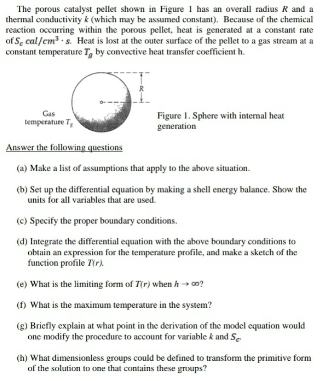The porous catalyst pellet shown in Figure 1 has an overall radius R and a thermal conductivity k (which may be assumed constant). Because of the chemical reaction occurring within the porous pellet, heat is generated at a constant rate of Se cal/em s. Heat is lost at the outer surface of the pellet to a gas stream at a constant temperature T, by convective heat transfer coefficient h. Gas bemperature T, Figure I. Sphere with internal heat generation Answer the following questions (a) Make a list of assumptions that apply to the above situation. (b) Set up the differential equation by making a shell energy balance. Show the units for all variables that are used. (c) Specify the proper boundary conditions. (d) Integrate the differential equation with the above boundary conditions to obtain an expression for the temperature profile, and make a sketch of the function profile T(r) (e) What is the limiting form of T(r) when h co? (f) What is the maximum temperature in the system? (g) Briefly explain at what point in the derivation of the model equation would one modify the procedure to account for variable k and S. (h) What dimensionless groups could be defined to transform the primitive form of the solution to one that contains these groups?
The porous catalyst pellet shown in Figure 1 has an overall radius R and a thermal conductivity k (which may be assumed constant). Because of the chemical reaction occurring within the porous pellet, heat is generated at a constant rate of Se cal/em s. Heat is lost at the outer surface of the pellet to a gas stream at a constant temperature T, by convective heat transfer coefficient h. Gas bemperature T, Figure I. Sphere with internal heat generation Answer the following questions (a) Make a list of assumptions that apply to the above situation. (b) Set up the differential equation by making a shell energy balance. Show the units for all variables that are used. (c) Specify the proper boundary conditions. (d) Integrate the differential equation with the above boundary conditions to obtain an expression for the temperature profile, and make a sketch of the function profile T(r) (e) What is the limiting form of T(r) when h co? (f) What is the maximum temperature in the system? (g) Briefly explain at what point in the derivation of the model equation would one modify the procedure to account for variable k and S. (h) What dimensionless groups could be defined to transform the primitive form of the solution to one that contains these groups?
Related questions
Question

Transcribed Image Text:The porous catalyst pellet shown in Figure 1 has an overall radius R and a
thermal conductivity k (which may be assumed constant). Because of the chemical
reaction occurring within the porous pellet, heat is generated at a constant rate
of Se cal/em s. Heat is lost at the outer surface of the pellet to a gas stream at a
constant temperature T, by convective heat transfer coefficient h.
Gas
bemperature T,
Figure I. Sphere with internal heat
generation
Answer the following questions
(a) Make a list of assumptions that apply to the above situation.
(b) Set up the differential equation by making a shell energy balance. Show the
units for all variables that are used.
(c) Specify the proper boundary conditions.
(d) Integrate the differential equation with the above boundary conditions to
obtain an expression for the temperature profile, and make a sketch of the
function profile T(r)
(e) What is the limiting form of T(r) when h co?
(f) What is the maximum temperature in the system?
(g) Briefly explain at what point in the derivation of the model equation would
one modify the procedure to account for variable k and S.
(h) What dimensionless groups could be defined to transform the primitive form
of the solution to one that contains these groups?
Expert Solution
This question has been solved!
Explore an expertly crafted, step-by-step solution for a thorough understanding of key concepts.
This is a popular solution!
Trending now
This is a popular solution!
Step by step
Solved in 6 steps with 3 images
